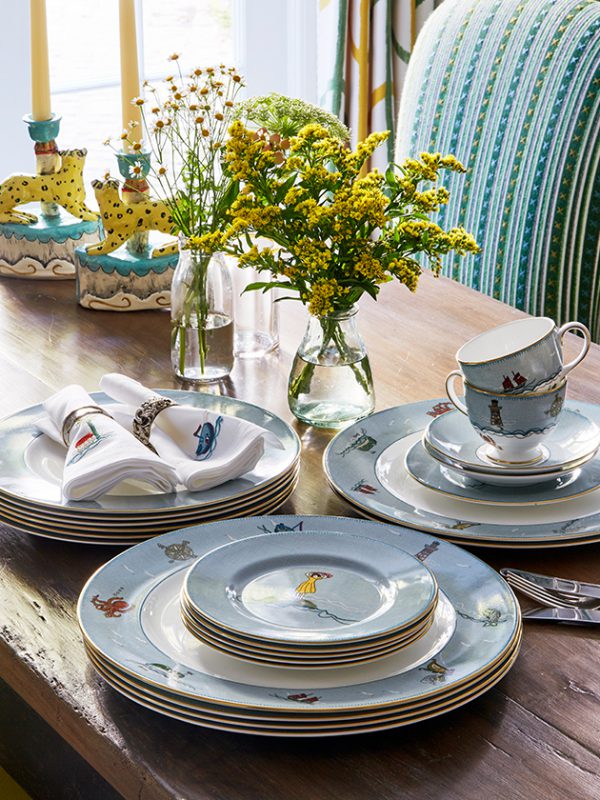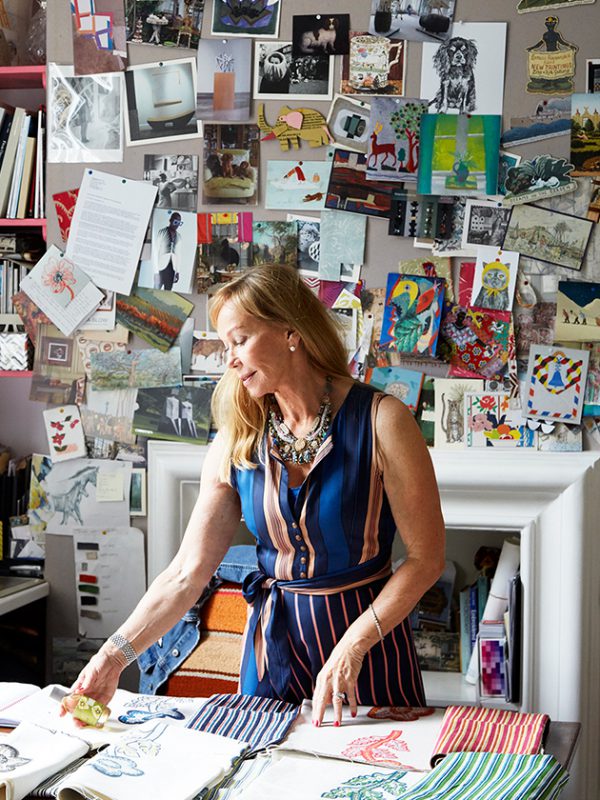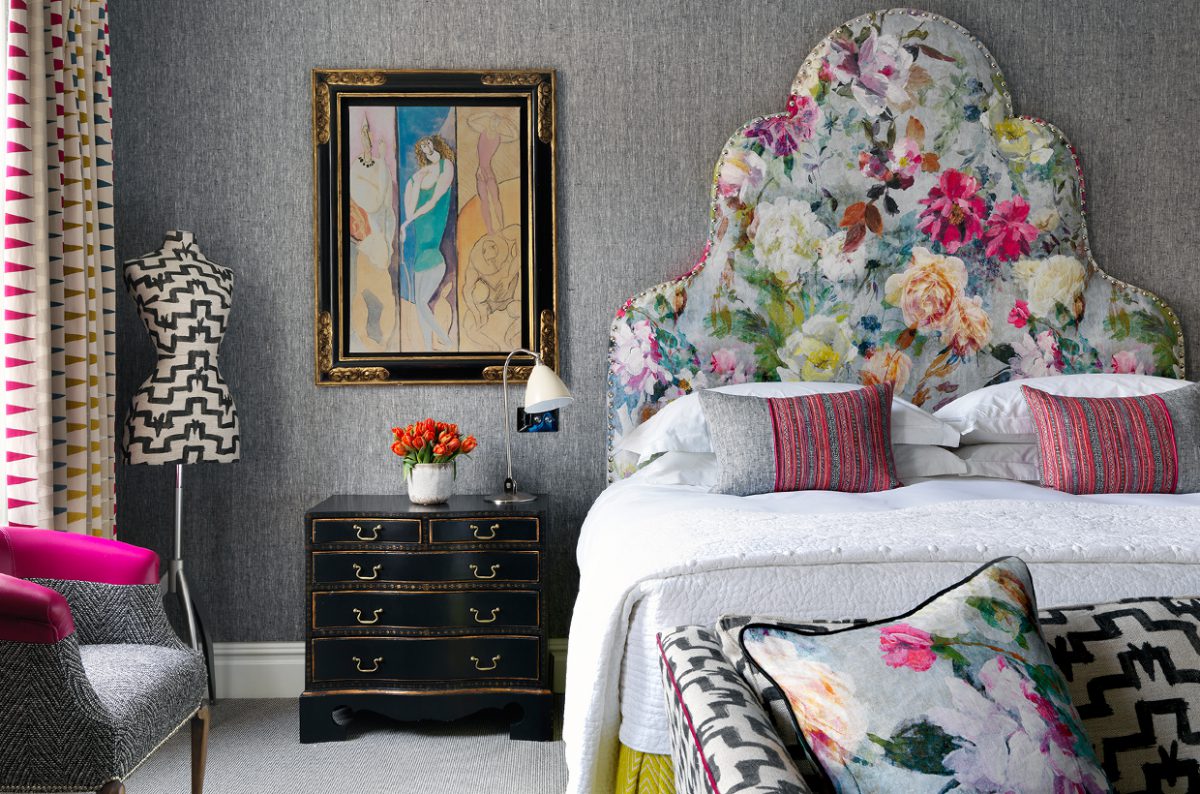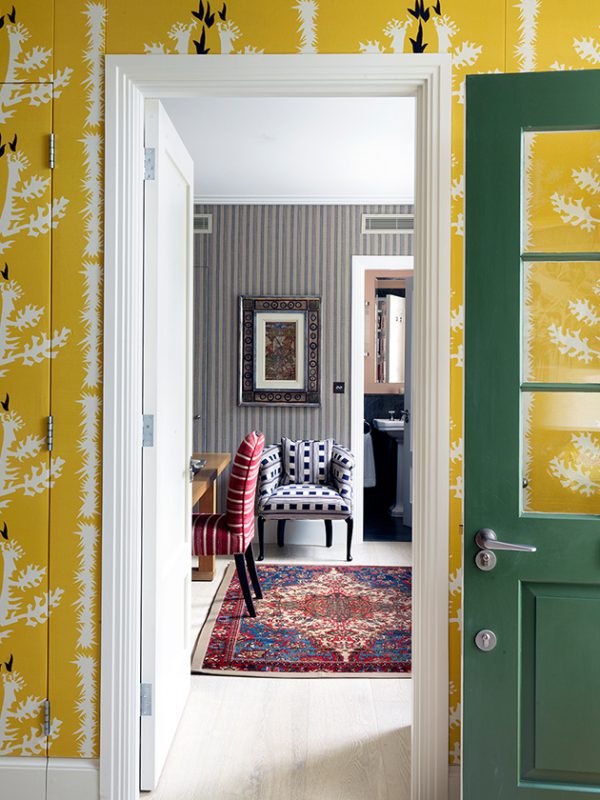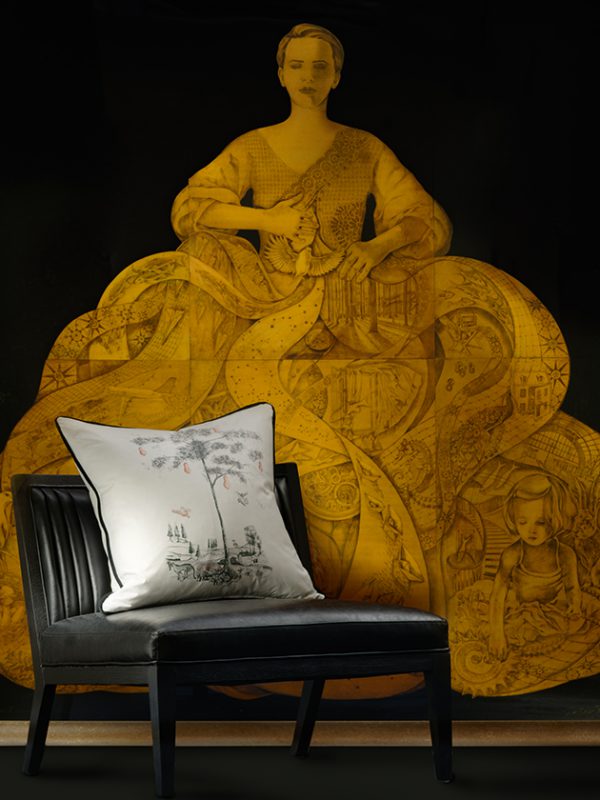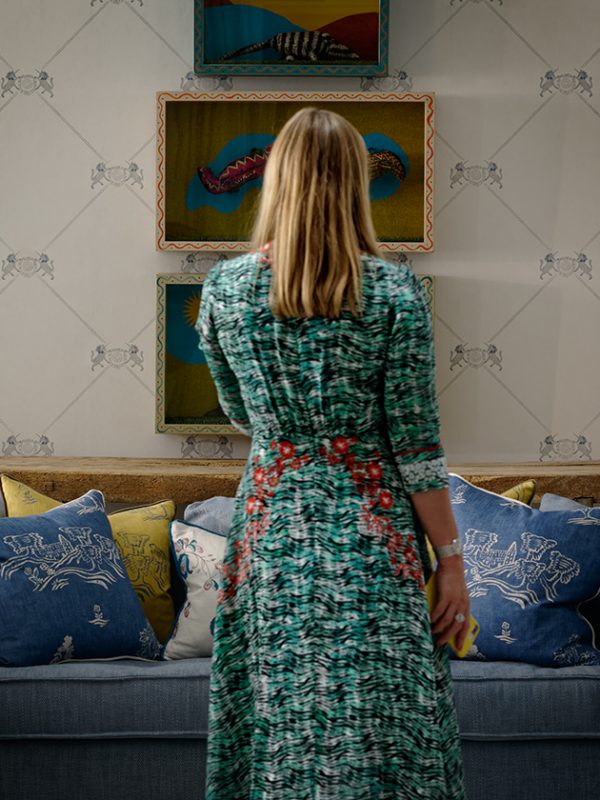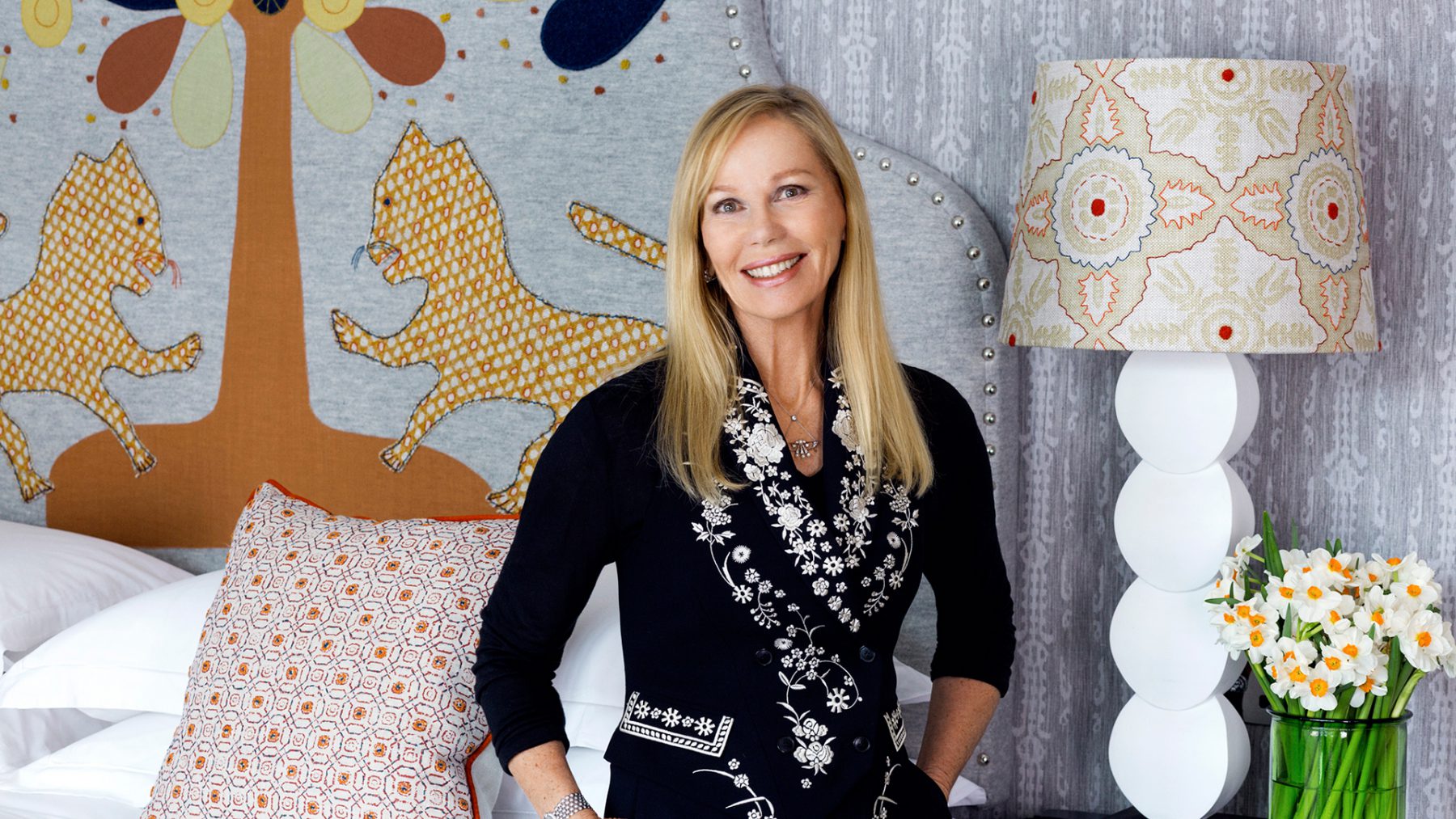Have a break, stay with Kit Kemp by Michaela Cordes | 7th June, 2019 | Personalities
With her humorous designs and unusual sense for color, Kit Kemp is making waves beyond her own hotels in London and New York. The British interior designer talks about her small but exquisite collection.
“We want to pique people’s curiosity – but also provide a place where they feel taken care of and at home.” Kit Kemp
It’s 8:30 in the morning on a gray day in London’s Soho district, but inside the restaurant of the Ham Yard Hotel the sun is rising: Bright yellow wallpaper, orange colored chairs and the fresh green plant decorating the crisp white tablecloth of my breakfast table instantly put a smile on my face when one happy waitress unfolds my napkin and places it on my lap with a cheerful “Good morning!” A good mood seems included with the package whenever you book a room at one of the ten luxury properties that form Firmdale Hotels, located in London and New York. This fine and steadily growing collection of hotels in distinct and handpicked locations belongs to British couple Tim and Kit Kemp, who have developed the brand that is today known for an unusual mix of individually decorated properties in charming neighborhoods, with colorfully patterned wallpapers, high-quality handmade fabrics and fun ideas, such as the integration of a cinema or bowling alleys into the hotel basements.
Beyond being admired in the hospitality industry, Kit Kemp has also become a globally celebrated interior designer who, in addition to creating wallpaper, tableware and carpets, just published her third book, Design Thread. On the evening before, I had the pleasure of listening to one of Kemp’s regular talks at the Firmdale’s Haymarket Hotel around the corner together with 40 other guests who were also keen to learn more about the skills of this interesting interior designer. Today I’m meeting up with the mother of three grown daughters at the Ham Yard Hotel in the Drawing Room adjacent to the restaurant – to chat about her life, inspiration, her creative partnership with her husband and her expanding business.
Mrs. Kemp, along with your husband, Tim, you currently oversee ten hotels – 642 hotel rooms in total – in two cities. You’ve not only made a name for yourself with your unusual interiors, but you’re also admired in the industry for maintaining complete ownership over the Firmdale Hotel group to this day. This is quite unusual… I guess you’re right. But you know, we’ve never gone for world domination. When I see, for example, how hotels like the Soho House are expanding – even into Mumbai and Istanbul – I am amazed, but we never looked at our business like that. I love to do one project at a time and do it really well. We don’t really feel the need to make it too much of a formula. For us it is all about the soul. And we do really care very much. How much, I realized again last night after the talk when I was having supper with Tim. We were talking about all the different things going on, and then we had to stop ourselves, because we were getting too passionate about our hotels. And as we both feel strongly about them, we are more likely to argue. Fortunately, we’ve been together long enough that we’ve learned how to handle these things: We usually just change the subject. [Laughs]
Is it true that your career began when you fell in love with your husband? Yes, that’s right! That was in the 1970s. Back then, Tim was a client of Leszek Nowicki, the architect I worked for when I was younger. Leszek was always very supportive of me, and at his wedding, he sat Tim and me next to each other. Tim owned several buildings in South Kensington and was in contact with colleges in the U.S., including Richmond College, among others, that needed accommodations for their students in London. Tim mainly built these two-star accommodations where four to five students lived together.
You both opened your first hotel, Dorset Square, in 1985. Who came up with the idea? Tim had been planning on building a hotel for a long time. As the child of a patent attorney, he had stayed in lots of hotels and loved hotel life. I, on the other hand, hated hotels because as a child I always had to go with my parents to the weddings of friends and relatives. For me, hotels were uncomfortable places that I associated with impatiently waiting for my parents. We ended up melding these disparate experiences and developing a common vision for our own hotels. The Dorset Square Hotel is still a very emotional place for us today. For me, it represents everything a hotel should be – just in miniature.
Your style, now a trademark of Firmdale Hotels, is characterized by a bold mix of fabrics, designs and colors, and has played a major role in your rapid success. Today, you also design wallpapers and work on collaborations with companies like Wedgwood and Anthropologie. Was there a particular moment when you noticed: That works well – we should open more hotels? [Laughs] The funny thing is, I don’t remember Tim ever asking me to handle the interiors, or anything. I realized early on that the less I get involved in Tim’s projects, the less I get to see my husband! So it was clear: Nobody else was going to do the interiors but me. Our second hotel was the Pelham Hotel, in an upgraded former student hotel known as The Cromwell. Sometimes a past resident would visit the new hotel and say how they hardly recognized their old room! Later, in 2008, we sold the Pelham to build the Crosby Street Hotel in New York. That was a good move, economically, since the pound was so much more valuable than the dollar at the time.
Where does your tremendous passion for exceptional fabrics and design come from? I think it’s more of a feminine thing that has a lot to do with history and tradition: I’ve always been fascinated by historical customs, like when a bride’s family would give her a chest full of all kinds of valuable fabrics to take to her husband’s house. Or the wedding quilt, where the quilters would sew good wishes into this lovely piece for the couple – I found this very romantic, even as a child. It’s this folk art side, more than the hightech side, that always inspired me. Also, I never could make a distinction between craftsmanship and art. True artists would always say that craftsmanship is the art of the poor man, but I’ve never seen it that way. And today these two sides are coming together more and more, because suddenly we appreciate old handmade fabrics more than we used to. Even though things go in and out of style. Tapestries, a good example, are very out of favor at the moment – because they’re too heavy.
What was your childhood like? I grew up in Hampshire with my two older brothers. Our mother worked for the BBC and our father was an aircraft designer: I have very vivid memories of our beautiful placemats with all of these sleek and colorful jets on our dinner table. As a child I was fascinated by embroidery and especially by the colorful silk we worked with at school. I’m left-handed, so actually I was quite clumsy when it came to handicrafts. But I remember that my teachers would often use my artworks as examples to show to the class, because my style was abstract – and slightly controversial – and my teachers noticed that I had a different eye. At home I’d often spend hours on end making colorful clothes for my dolls.
“I was clumsy as a child but I’ve always been passionate about color.” Kit Kemp
In 2009, you opened your first hotel in the U.S.: the Crosby Street Hotel in the heart of SoHo, in NYC. These days, you find all kinds of celebrities meeting up there for brunch or high tea. What made you decide to take the leap from London to the other side of the pond? That was entirely Tim’s idea; I wouldn’t have taken such a step on my own [laughs]. Tim has this ability to see the finished project vividly in front of him and to bite into new endeavors like a Jack Russell that just won’t let go. The Crosby was a big challenge because we were building on a former parking lot, and we needed to get all the neighbors on board before we could begin construction. But that’s actually always a part of our goal anyway: We want to become part of the neighborhood with our hotels, to enrich the community. This applies to both New York and to London. For Ham Yard, for example, before we even started building, we bought fully grown oak trees for the courtyard in front of the hotel, which now connects all the small shops around us. And since we knew we wanted to build an underground cinema and bowling alley, we only started with the real planning of the hotel layout once we knew how deep the tree roots went.
You’re currently working on a new hotel in New York. What are you aiming for here? In New York we’re working on our third hotel in Manhattan. It will have 85 rooms and is going to be on Warren Street in Tribeca, not far from the Oculus building [editor’s note: on the Ground Zero site] in Downtown Manhattan, which we really love, since the hotel will bring new life to this very historic area. Our typical guests are busy people who often travel back and forth between London and New York, and we want to pique their curiosity, to give them that fantasy, like, “what if I get to meet an interesting new like-minded person here?” Or to provide them with a place where they feel taken care of, where they can feel at home when they’re far away from their families and loved ones.
What do you think is more important for good business: the design or the service? Both! This is the biggest challenge: In the hotel industry, all of these different aspects – all of these tiny details – have to fit together for it to really work. What’s the use of arriving in a beautifully decorated hotel room only to have to wait hours for room service? That’s why we created a training center here in London, right next to the Soho Hotel, where we train our entire staff. Currently, we have just under 2000 employees representing 76 nationalities. They’ll work in rotations at different hotels for six months at a time, then pass through our graduate program where there’s the opportunity to build a career within the group and work up to a better position.
“They used to say that craftsmanship was the art of the poor man, but I’ve never seen it that way. They’re coming together more and more.” Kit Kemp
Have you ever thought about expanding into other cities? Yes, we’ve definitely looked around, for example in Los Angeles. But so far we haven’t found the right location or – more importantly – a suitable property or site. I’d personally love to develop a hotel out in the countryside here in England, but quality control and ensuring that the services and facilities are in perfect order is a challenge in this part of the business, and it’s easier to keep tabs on our hotels if they’re only in two cities. We renovate every five years on average, but I’m not just talking about freshening up individual pieces of furniture or changing certain details: We never only change one item but entire rooms. At the Crosby Street Hotel, for example, we have just finished a complete renovation of all rooms and suites.
That sounds like a lot! With this kind of workload, how are you able to relax and recharge your batteries? I have a pretty busy schedule, but I thrive on that. My day starts early, at 7:00 a.m., when a personal trainer arrives to get me going – I wouldn’t be able to work out on my own since I’m the laziest person ever! I either train on the elliptical trainer or do a bit of weights. When the weather is nice, I also like to go out in the fresh air – I used to run a lot and even took part in two New York marathons, but that was before we opened our first New York hotel in 2009. After this, I head over to the office to meet with the design team, look at new fabrics and discuss interiors. Then I spend some time answering emails, and in the afternoon I make my way to our hotels around London to check in on things. In the evening, we’re often invited out – but when we stay in, Tim and I split up the responsibilities: He shops and I cook. It works out beautifully, since I hate shopping in the supermarket! [Laughs]
Recently you’ve also become active in the digital world: Through your blog Kit Kemp’s Design Thread and your Instagram account @kitkempdesignthread, you show design enthusiasts new ways to approach home furnishings. Do you have fun working in the new media field? Oh, yes – very much so! On Wednesdays I meet up with our blog team, and this is my absolute favorite day of the week. We sit together at a round table and discuss our diverse views on interior decorating, which fabric goes with which piece of furniture, and so on. We also develop workshops where we teach participants how to create personalized, inspiring living spaces. I always encourage my team to seek out new inspiration in museums or exhibitions. This weekly exchange is always very creative and inspiring.
Do you ever feel the need to switch off completely? Absolutely. Every Friday afternoon I get in my car and drive about two and a half hours to our weekend house in the New Forest, Southern England, so that I get to wake up out in the countryside on Saturday morning. The house is very close to my eldest daughter’s house. We have our dogs there, and lots of dear old friends who are not very interested in our business. So Friday evening to Sunday evening, when we finally return to London, is always our time to hit pause and take a very necessary break.
